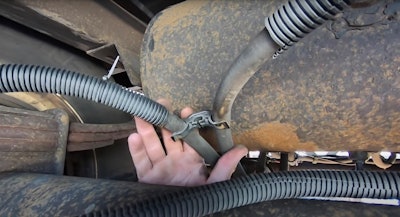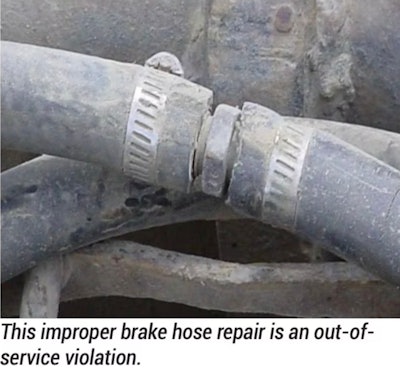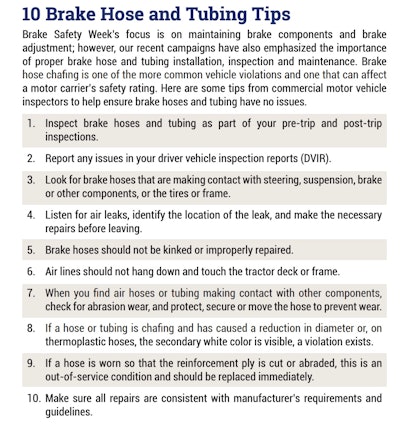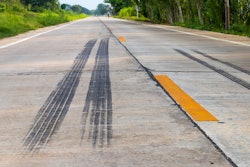
As the Commercial Vehicle Safety Alliance’s Brake Safety Week approaches next month, experts offered insights and tips into one of the more common violations: brake hose chafing.
Brake violations regularly make up the majority of out-of-service violations, according to the CVSA, and during the upcoming Brake Safety Week on Aug. 21 – 27, inspectors in the U.S., Canada and Mexico will be checking entire brake systems to help ensure vehicle safety.
[Related: Want more brake maintenance tips? Download CCJ's updated Air Brake Book here.]
 CVSA recently published a flyer addressing brake hose chafing in preparation for Brake Safety Week, Aug. 21 - 27. "The hose should be replaced if damaged," said Brian Screeton, supervisor of technical service training at Bendix Commercial Vehicle System. "If it is caught early enough and the hose is not damaged, correct the hose routing or install the proper length hose if the wrong length has been installed."CVSA
CVSA recently published a flyer addressing brake hose chafing in preparation for Brake Safety Week, Aug. 21 - 27. "The hose should be replaced if damaged," said Brian Screeton, supervisor of technical service training at Bendix Commercial Vehicle System. "If it is caught early enough and the hose is not damaged, correct the hose routing or install the proper length hose if the wrong length has been installed."CVSA
“Chafing of an airline is typically from the line rubbing or touching something that leads to this kind of wear,” said Joe Kay, drivetrain engineering director at Meritor. “Air lines can also see damage from being bent and flexed constantly, which is a form of fatigue.”
Life on the road is tough. With trucks constantly hitting the highways, chassis, suspension, powertrain and other components (including brake hoses) are subject to movement, which can provide opportunities for chafing if hoses are not carefully routed and properly attached.
“Anytime hoses are permitted to move there is potential for lines to rub,” said Transervice vice president of maintenance Matt Copot. “There are also times when objects might move brackets and create issues where lines are now touching as a result of brackets being moved and/or broken away.”
In addition to movement, improper brake hose length can also lead to chafing.
“If a replacement brake hose is installed and it is too long, it will be hard to install without there being a possibility of chafing,” said Brian Screeton, supervisor of technical service training at Bendix Commercial Vehicle System. “The correct length hose should always be used."
So who’s installing the wrong-sized brake hose which can lead to a costly OOS violation? It’s not OEMs.
“By far, most hose chaffing issues are caused by previous repairs,” explained Daniel Mustafa, director of technical service at Travel Centers of America. “When a truck technician does not reinstall the various clamps and routing hardware it allows the hose to move in a way that the manufacturer did not intend.”
Inspect and correct
Inspecting and replacing damaged brake hoses during pre and post-trip inspections is the best way to avoid costly violations. Chafing leaves behind some pretty noticeable clues as most inspectors can attest.“By conducting routine visual inspections, most damaged lines that have occurred from rubbing can be seen,” Kay said. “Typically, it’s a color difference or the hose may not appear to be round where it touches an object. Look at the ends where the connectors are for damage due to flexing or the organic material stretching and ripping.”
 Improperly repaired brake hoses can lead to out-of-service violations as CVSA makes clear above.CVSA
Improperly repaired brake hoses can lead to out-of-service violations as CVSA makes clear above.CVSA
“Lines that are not located close to frame rails or on the upper interior side of channels are more prone to having chafing issues,” Copot explained. “In addition, lines that span open areas or provide for movement will be prone to chafing. Look at these areas as opportunities to provide spacing or even rerouting options to eliminate the potential of chafing, which lead to increasing CSA scores.”
Screenton advised to conduct periodic inspections to ensure that tie straps, clips and brackets that support hose routing are not damaged or broken. Also, carefully follow hose paths to check for possible friction points.
“Look for hoses that are close to and part of the chassis or axle,” Screenton said. “When inspecting a hose, even if is not touching anything, keep in mind that the axle will be moving relative to the chassis.
“If the hose is close but not touching when the vehicle is parked during an inspection," Screenton continued, "does the hose have enough clearance when the vehicle is in operation and the chassis, axle and suspension are in motion?”
With improper repairs causing most hose chafing issues, Mustafa recommends being especially diligent following a repair by asking three questions, which may make the difference in keeping a truck on the road or getting it grounded with a costly violation: “Are all clamps and routing hardware in place? Do the hoses seem to be routed in a way that will prevent the hoses from contacting moving parts? Do the hoses seem to be excessively loose or tight, which would be evident from the lines being excessively loose or tight?”
In addition to looking for damaged lines and supporting hardware, including hose springs, look closely at air pressure readings and listen up.
“The best is conducting visual inspections like looking for worn surfaces but also listening for air leaks, and monitoring your air gauges to ensure excessive air is not being consumed, and replacing anything suspicious,” Kay said.
 CVSA's brake hose and tubing tips. "It’s important to make sure there is adequate length of brake line so the suspension can move up and down in travel and on steerable axles the knuckle can make full rotations without pulling on the line," said Joe Kay, drivetrain engineering director at Meritor. "As air disc brake pads wear, the caliper will need to move at least 1-inch to accommodate the wear so the line length needs to be assured."CVSA
CVSA's brake hose and tubing tips. "It’s important to make sure there is adequate length of brake line so the suspension can move up and down in travel and on steerable axles the knuckle can make full rotations without pulling on the line," said Joe Kay, drivetrain engineering director at Meritor. "As air disc brake pads wear, the caliper will need to move at least 1-inch to accommodate the wear so the line length needs to be assured."CVSA












